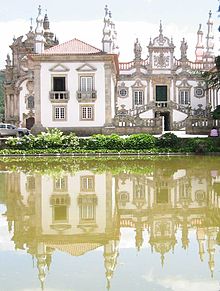Vila Real is a city of 52,000 people (2011) the Trás-os-Montes e Alto Douro region in Northern Portugal. It is the home of the beautiful Palácio de Mateus.
Understand
edit
Vila Real (VEE-luh rree-AHL, /ˈvi.ɫɐ ʁi.ˈaɫ/) has 51,850 residents (2011), with 29,624 residing in the city proper.
Sitting on a plateau at the confluence of the Corgo and Cabril rivers, the city is framed in a beautiful natural landscape (Escarpas do Corgo), with the backdrop of the mountains of Alvão and, further away, Marão. Over more than seven hundred years of existence, Vila Real has gained the contours it has today, a city of beautiful monuments, where the temples and noble houses stand out. It used to be known as the Corte de Trás-os-Montes, because the Marqueses of Vila Real lived in it and had a palace. This noble family had a close family connection with the Portuguese Royal House.
History
editThe region shows traces of habitation from the paleolithic era, while the settlement of Panóias had a Roman presence. Vila Real was founded in 1289 by King Denis of Portugal, hence its name, meaning Royal Town. It housed more members of the royal family during the Middle Ages than any other settlement in Portugal except the capital in Lisbon, and family Coats of Arms remain above old houses, some of which still occupied by those families. Vineyards were introduced to the municipality in 1764, growing red, white and rosé wines for export.
Visitor information
edit- 1 Loja Interativa de Turismo Vila Real (Viver Vila Real), Avenida Carvalho Araújo 110. Daily 09:00–13:00 & 14:00–18:00.
Get in
editBy car
edit- A24 - Connects Chaves (frontier with Galiza, Spain), to the north, and Viseu, to the south.
- A7 - Indirect connection to Minho (Braga, Guimarães, etc.), from Vila Pouca de Aguiar, via A24.
- A4 - Main Road that connects Porto, to the West, and Bragança, Northeast and the frontier with Castilla y Leon, Spain.
By plane
editGet around
editThe city bus system in Vila Real is run by Urbanos Vila Real; there are 5 lines.
See
edit
- 1 Casa de Mateus (4 km (2.5 mi) from the centre of Vila Real on Estrada Nacional 322, in front of the old Rua da Moura; by Urbanos Vila Real bus, line 1 from Mateus, next to the Parish Church), ☏ +351 259 323 121, casademateus@casademateus.pt. The Palace consists of the main house, the gardens, the cellar and a chapel. Inside the house there is a library with 6000 volumes, where the famous illustrated edition of the Lusíadas by Luís de Camões from 1816 stands out and in the remaining divisions of the house, numerous pieces of furniture, carpets, crockery, robes and relics can be seen. Wine tastings available. Guide tour and gardens: adult €13.00, child 6-12 €6.50, student up to 25 €9.75; gardens only: €9.50/€4.75/€7.00; family rates.
- 2 São Brás Chapel. A National Monument since 1910, it contains the tombs of Teixeira de Macedo and Lourenço Viegas, son of D. Egas Moniz.
- Chapel of Espírito Santo or Chapel of Bom Jesus do Hospital
- 3 Diogo Cão's house (Casa de Diogo Cão). It was built in the second half of the 15th century. The navigator Diogo Cão was reputedly born here. He was the first European to find the mouth of the Congo River.
- Casa de Carvalho Araújo, an important sailor who stood out in his profession, for having prevented the escort boat (the steam ship S. Miguel) from being sunk by a German submarine, sacrificing the mine-dredge he commanded (NRP Augusto de Castilho) and your own life.
- Casa dos Brocas, built by Camilo Castelo Branco's grandfather and where he lived for some time.
- Casa dos Marqueses of Vila Real, with a beautiful Manueline style window , where they lived until they fell out of favour due to their involvement in the conspiracy against D. João IV, in 1641.
- Church of Mercy
- Church of São Domingos / Sé de Vila Real
- St. Peter's Church
- Church of Bom Jesus do Calvário
- Church of São Paulo / Capela Nova, of baroque style, whose authorship is attributed to Nicolau Nasoni
- 4 Pillory of Vila Real (Pelourinho de Vila Real).
- 5 Ponte de Piscais (Piscais Bridge). A Roman bridge that allowed the crossing of the Corgo River by a Roman road that crossed the entire Iberian Peninsula.
- 6 Quintela Tower (Torre de Quintela) (in the parish of Vila Marim). This medieval tower was built during the reign of D. Afonso III (1248-1279), by order of D. Alda Vasques , who used it as a stately home.
- Bairro da Judiaria de Vila Real, one of the most interesting housing developments, with the entrance before the Metallic Bridge over the Corgo River and through there the ancient Roman and medieval road, with the primitive bridge.
Do
editBuy
edit
- 1 Bisalhães Black Pottery, Mondrões.
Eat
edit- 1 Cais da Villa, Rua Monsenhor Jerónimo do Amaral 6, ☏ +351 259 351 209, geral@caisdavilla.com. M–Th 12:30–15:00 & 19:30–00:00, F Sa 12:30–15:00 & 19:30–02:00, Su 12:30–15:00. Trás-os-Montes regional cuisine, including cataplana of grouper, squid and shrimp. Awarded the Michelin Plate for "good cooking". Splurge.
- 2 Forneria, Rua António Azevedo 86, ☏ +351 259 372 039, geral@forneria.pt. M–Sa 12:00–14:30 & 19:00–22:30, closed Su. Italian restaurant and pizzeria. €7-18.
- 3 Terra de Montanha, Rua 31 de Janeiro 28, ☏ +351 259 372 075, vilareal@terrademontanha.pt. M–Sa 12:30-14:30 & 19:30–22:30, Su 12:30-14:30. Regional Trás-os-Montes cuisine. Mid-range.
Drink
editPraça Pioledo in the city centre has a set of bars around.
Sleep
edit- 1 Hotel Miracorgo, Avenida 1º de Maio 76, ☏ +351 259 325 001, info@hotelmiracorgo.com. Check-in: 14:00–20:00, check-out: 07:00–12:00. 4-star hotel.
- 2 Hotel Quinta do Paço, Estrada Nacional 322, Arroios, ☏ +351 259 340 790, hotel@quintapaco.com. 4-star hotel.
- 3 Douro Village Hostel, Rua 31 de Janeiro 44, ☏ +351 259 042 294, info@dourovillage.pt. Hostel.

